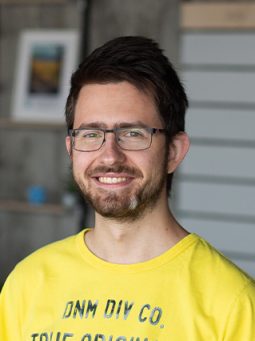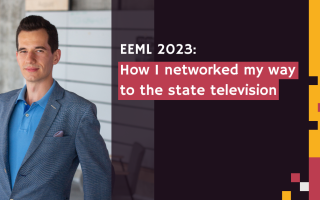What's
Insider’s notes from an award-winning A-ranked conference RecSys
As a PhD student at the Kempelen Institute of Intelligent Technologies in Bratislava (KInIT), I attended the ACM international conference on Recommender Systems (RecSys) in Amsterdam.
The recommender systems, whose main purpose is to recommend things based on user activity and other factors, are an increasingly discussed topic even in mainstream non-tech media. They significantly change what we see on social media and shape our user experience, which transfers into change of our values, lifestyle and choices we make as citizens and human beings.
The focus of the conference was not only on the advancements of recommender systems, e.g. how to produce better recommendations. Recently, this focus has shifted towards bias, privacy and fairness, along with studying and limiting impact on society and users, such as promoting biases, or deepening distrust in scientists and authorities.
I presented our paper, “An Audit of Misinformation Filter Bubbles on YouTube: Bubble Bursting and Recent Behavior Changes”, in which we investigated the filter bubble behavior on YouTube. Later, when I was standing on the podium, receiving the Best Paper Award, I felt rather proud and I wished the whole team was standing there. It was a huge achievement, as the conference is on the list of the best-ranked conferences (A-ranked in CORE).
In this article you will read:
- my insider’s view with the most memorable experience I enjoyed as a presenter and a student volunteer
- my selection of interesting presentations such as the three keynotes, several papers and case studies
- some information about the conference organization and background
Insider’s view
The main point of every (not only scientific) conference is not only to attend presentations of other interesting papers but also to network and build connections. It is an opportunity to meet other researchers working on similar topics, discuss your work with them, get new ideas about the work, and, potentially, pave the way for future collaborations. We all enjoyed attending the paper presentations, talking about them with each other.
I was one of the presenters, so during the breaks and free time, other researchers stopped by and asked about the presented work, asking for more details, sharing their ideas and questions, which was both pleasant and inspiring.
Being a student volunteer gave me a glimpse into a conference background and even more networking opportunities. As volunteers, we were the first contact for the attendees and we were wearing bright orange T-shirts and hoodies so that we would be visible. Even the attendees who may be a bit shy to talk to others were quite comfortable talking to us, having a good reason to ask for information. It also worked the other way around. Being an introvert myself, I felt more comfortable initiating conversations even with those I had considered to be authorities. And I had a good excuse for it – it was one of our jobs as volunteers to interact with others.
Being a student volunteer had one more benefit for me. The volunteers were usually PhD students or finishing their Master’s degree and considering a PhD. Simply, the people at the same or similar stage of a research career like me. I met over 30 people at one place, who I might not had met otherwise. The talks with them were inspiring, productive and creative.
All in all, attending the conference on-site was a valuable experience and face to face networking is irreplaceable. Attending the conference as a student volunteer gave my experience an extra layer, more fulfilling and fruitful, and I took more from it than I had thought I would.
Bias and fairness in recommender systems was hot topic
Apart from the keynotes, there were many interesting papers. It is rather difficult to choose from the variety of great works presented during the conference week, but I will now try to share some of the most interesting and inspiring with the focus on the bias, fairness, and the problems of misinformation in everyday use of the recommender systems.
Natali Helberger: Regulations and AI
Natali Helberger, a professor of Law and Digital Technology with a special focus on AI at the University of Amsterdam, described her keynote on the upcoming regulations and legislative changes, such as Digital Services Act and the Digital Markets, Data Governance Act, and Artificial Intelligence Act that are currently being written/developed by the European Commission.
The proposed regulations are meant to combat the problems of filter bubbles and echo chambers by forcing social media platforms to be more transparent and explain to the users, that something was shown or hidden and why. It is an important first step, but may not be sufficient and might come a bit late – as the users may not want to change anything.
Cynthia Liem: Popular or not?
Cynthia Liem provided a multidisciplinary view of the recommender systems and their possible problems in her keynote, as she is also a pianist, now working on recommender systems development. She brought up an inspiring insight into recommendations from the perspective of a musician, which she supported by a case study from her life.
She described how one of the really beautiful and complicated songs, which was forgotten by the public and by the musicians as well, slowly became more popular and high on demand, after it was played some 10 – 15 times in concerts.
She postulated that what is popular may not be what people are really looking for, and they may want some diversity. Even the majority of the classical pieces we listen to today, and the notoriously famous composers, such as J.S.Bach, have become popular and celebrated only recently, after more than 200 years. Perception of what is popular changes in course of time. It is, therefore, important to empower people to choose what they would listen to without recommendations, by changing how the recommenders work and allowing the users an easier exploration.
Max Welling: Graph Neural Networks
In his keynote, Max Welling focused on Graph Neural Networks and their use for the recommender systems. This keynote was interesting mostly for researchers and scientists attending the conference, so I will not go into details in this article.
Tim Donkers: Dual Echo Chambers
Filter bubbles and echo chambers are common problems on social media platforms. Any average consumer may have encountered them. Tim Donkers presented the paper with the study of echo chambers.
Previous studies on echo chambers received a slight critique, as they only considered the echo chambers to be a result of lack of coverage. However, there are basically two types of echo chambers. The first type is indeed caused by a missing connection to other information. We call them epistemic, and they are rather rare. The second one is ideological. There is access to a variety of information, but there is an active discredit of some information. These echo chambers are more prevalent and create the basis for most of the conspiracy theories and hoaxes.
Dor Lavi: Job matching with AI
We, as human beings, are not really able to be perfectly objective in all our choices. For example, by encountering CVs written in other languages, recruiters can unconsciously form a biased opinion and treat the candidate differently. In addition, in multinational companies, the job descriptions and CVs can be in different languages, and matching them automatically may prove difficult. Dor Lavi from Randstad (personnel services agency) has shown in the paper that AI could help by providing a fairer and bias-free approach that can work with job descriptions and CVs in different languages.
In this work, the researchers used a popular technique, called BERT, or more specifically multilingual BERT, for representing the job descriptions and CVs in machine-understandable format and matching them together. The results were impressive, as their proposed approach worked really well across different languages and professions.
Using such approaches may be the future for the job market and so the SlovakBERT, a model developed by KInIT in cooperation with our partner GERULATA, may find use in it as well. We shall see.
Daniel Kershaw: Fairness in reviewer recommendation
Bias and unfairness can also be found in the academic world. These problems were studied and countered in a case study presented in the paper by Daniel Kershaw from Elsevier. The results show that women and some protected groups, based on gender, race and age, receive fewer citations and have worse academic metrics due to biases. Based on the results from the study, the authors of the paper have evaluated various approaches for dealing with this problem.
By applying the approaches for dealing with biases, such as prohibiting the use of sensitive, protected features, and the features highly correlated with them, they can provide fairer and bias-free evaluations of journal reviews and can find reviewers more efficiently and more fairly.
Recommender Systems then and now
The history of the ACM RecSys conference goes back to 2007, when it took place in Minnesota, USA. It was built on a legacy of research workshops and the “Recommenders 06 Summer School on the Present and Future of Recommender Systems”. During its first year, RecSys attracted 35 long paper submissions and 23 short paper submissions from 15 countries. It is interesting to look back and compare how recommender systems were perceived in the relatively recent past. (Source: https://recsys.acm.org/recsys07/)
From its early days, ACM RecSys conference was a place where science has been meeting with industry in a close relationship. Back in 2007 recommender systems had emerged as “an important part of the solution to the information overload problem” and it was assumed or expected it would “provide users with proactive suggestions that are tailored to meet their particular information needs and preferences.” It seems natural that large commercial online services have become increasingly interested in them. (Source: https://dl.acm.org/doi/proceedings/10.1145/1297231)
Close ties between industry and science had been shown at the 15th year of the conference, too. Almost half of all presentations – 25, came directly from the industry. The key industry participants attending were AstraZeneca, Elsevier, Google, Facebook, Amazon and Netflix. The cooperations between industry and universities was represented in more than 5 presentations.
The conference was hosted in a variety of places across the world, such as Lausanne, New York, Barcelona, Chicago, Dublin, Hong Kong, Silicon Valley, Vienna, Boston, Como, Vancouver, Coppenhagen. In 2020 it took place online for the first time due to the Covid-19 pandemic.
In 2021, the conference was organized in a hybrid format, with part of the conference being held physically in Amsterdam, with a limited number of participants, and part of it online, using ZOOM and a platform for streaming, watching, and communicating with other participants, which was created specifically for the conference. The physical part of the conference lasted for 5 days (from Monday to Friday), with the online part lasting a bit longer (from Saturday to Saturday).
All in all, there were more than 60 speakers, about half of them presenting onsite, and the rest virtually. Besides speakers, there were also more than 20 participants presenting their results using posters and demos.
As it is typical at conferences, there were many opportunities for mingling and networking during coffee breaks. In addition, there were multiple social events for both online and offline participants, such as boat-tours around the city, karaoke nights on ZOOM, morning runs, and so on.
It is not easy to predict what the future has in store for us when it comes to conferencing in following years. I can, however, say that if there was another chance to attend another conference live, I would definitely go for it again.


